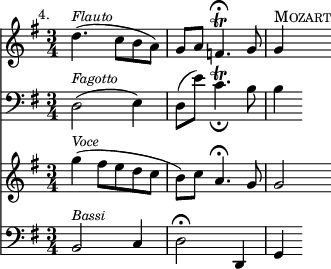Sometimes in similar passages the accompaniments are given to a few wind instruments with charming effect, as in the following examples by Mozart. For the sake of comparison we shall in each instance give the score in its original state before quoting it with the additional parts. Our first example is from the close of the song 'What passion,' in the 'Ode for St. Cecilia's Day.'




In the first of the foregoing quotations (No. 4) it will be seen that Mozart has simply added in the flute and bassoon the harmony which Handel no doubt played on the harpsichord. In the next (No. 6), from 'He was despised,' the harmony is a little fuller.
In all the above examples the treatment of the harmony is as simple as possible. When similar passages occur in Bach's works, however, they require a more polyphonic method of treatment, as is proved by Franz in his pamphlet above referred to. A short extract from the 'Passion according to Matthew' will show in what way his music can be advantageously treated.
![{ \override Score.Rest #'style = #'classical \time 3/8 << { \new Voice = "voce" \clef treble \key a \major { fis'8([^\markup { \small \italic Voce } dis'')] bis' | fis'([ gis'16 fis')] e'( dis') | e'8([ cis'')] b' | a'16([ gis' fis' eis')] fis'8 } }
\new Lyrics \lyricsto "voce" { dir ge -- bäh -- ren treu -- er Je -- su }
\new Staff { \clef bass \key a \major { a16(^\markup { \small \italic Bassi } gis fis e dis cis) | bis,8( gis, bis,) | cis16( b, a, gis, fis, eis,) | fis,8 gis, a, } }
\figures { < 6 >8 < 6 >8 < 6 >8 < _ >4. < _ >4 <5 4 2>8 < _ >4 < 6 >8 }
>> }](http://upload.wikimedia.org/score/o/q/oqj51ioimi1gt7lpq2brgw7hr8js293/oqj51ioi.png)
The figures here give the clue to the harmony, but if simple chords were used to fill it up, as in the preceding extracts, they would, in Franz's words, 'fall as heavy as lead among Bach's parts, and find no support among the constantly moving basses.' Franz therefore adopts the polyphonic method, and completes the score as follows:—
![{ \override Score.Rest #'style = #'classical
\key a \major \time 3/8
<< \clef treble
{ fis'8^\markup { \small \italic Viol. 1 } dis''16( cis'' bis' cis'') |
dis''8( bis') gis'16( fis') |
e'8( cis'' b') | a'16( gis' fis' eis') fis'8 | }
\new Staff
{ \clef treble \key a \major
{ cis'8(^\markup { \small \italic Viol. 2 } a' fis) |
dis'8( e'16 fis' e' d') |
cis'4 cis'8 | cis'4 a8 } }
\new Staff
{ \clef alto \key a \major
{ fis'8^\markup { \small \italic Viola } r fis16( a) |
gis4. ~ | gis | a8( b cis) } }
\new Staff
{ \new Voice = "voce" \clef treble \key a \major
{ fis'8([^\markup { \small \italic Voce } dis'')] bis' |
fis'([ gis'16 fis')] e'( dis') | e'8([ cis'')] b' |
a'16([ gis' fis' eis')] fis'8 } }
\new Lyrics \lyricsto "voce" { dir ge -- bäh -- ren treu -- er Je -- su }
\new Staff
{ \clef bass \key a \major
{ a16(^\markup { \small \italic Bassi } gis fis e dis cis) |
bis,8( gis, bis,) |
cis16( b, a, gis, fis, eis,) | fis,8 gis, a, } }
>>
}](http://upload.wikimedia.org/score/q/1/q1o7u3yvik9e54we39pi1pvjibm6umd/q1o7u3yv.png)
Somewhat resembling the examples given above is the case so often to be found both in Bach and Handel in which only the melody and the bass are given in the score. There is hardly one of Handel's oratorios which does not contain several songs accompanied only by violins in unison and basses; while Bach very frequently accompanies his airs with one solo instrument, either wind or stringed, and the basses. In such cases it is sometimes sufficient merely to add an inner part; at other times a somewhat fuller score is more effective. The following quotations will furnish examples of both methods.
